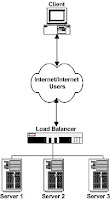
Typical Load Balanced Architecture
In this post I am going to discuss about Load Balancing in R12.
Load Balancing includes :
- HTTP Server
- DNS
- Concurrent Processing
- DB
Types of Load Balancers:
A) Session Persistent (Also ref as Stickiness) - Load Balancing
This type of load balancers are always direct HTTP requests (i.e, client connections) from a client to the same server (i.e, session-persistent).
B) Non-Session Persistent - Load Balancing
This type of load balancers are do not necessarily direct HTTP requests (i.e, client connections) to the same server. These load balancers use a round-robin strategy for balancing incoming HTTP requests and do not session persistent client connections.
C) SSL Accelerators
Reduces the SSL traffic and workload of the web server as this type of load balancers uses Secure socket layer Accelerators. Also converts SSL HTTPS client browsers request to non-SSL HTTP requests. It directs any further requests to the HTTP server.
Browser to receive response for its request a reverse process is used.
Types of Load Balancing:
a) HTTP Layer
This type of load balancing requires a hardware load balanacer (i.e, Athent Load Balancer in my current project used for hardware load balancer solution) that accepts HTTP communication and forwards it to a group (farm) of server nodes.
b) Domain Name System (DNS) Load Balancing
This type of load balancing distributes requests based on dynamic assignments of IP addresses to a FQDN (fully qualified domain name - for example: orar12.quickoracle.com).
c) Concurrent Processing Layer Load Balancing
This type of load balancing help you to run conncurrent processes on multiple nodes to improve concurrent processing throughput. You can administer concurrent managers from any node in the cluster running on multiple nodes. It also support if one concurrent processing node fail it continue running concurrent processes. This type of configuration is called PCP enabled (by default). For PCP configuration RAC environment is not required but it is good to have RAC node.
d) Database Layer Load Balancing
This type of load balancing all active instances help in concurrently running transactions in a shared database. RAC maintains data consistency and integrity to access shared data.
No comments:
Post a Comment